Beelink GTR7 mini-PC Review: A Complete AMD Phoenix Package at 65W
by Ganesh T S on August 24, 2023 8:00 AM ESTGPU Performance: Synthetic Benchmarks
AMD's Phoenix SoCs include an integrated GPU with a microarchitectural update over the one in the Rembrandt-R SoCs. The new RDNA3 microarchitecture is present in the Ryzen 7 7840HS in the form of the Radeon 780M. With 12 CUs and 768 shader units clocked at 2.7 GHz, AMD claims that the GPU should be capable of playing virtually any modern game at Full HD resolutions.
For full-blown desktop systems or mini-PCs targeting the gaming market, we look at gaming workloads. However, for general-purpose mini-PC models like the GEEKOM AS 6, we restrict ourselves to a series of canned benchmarks from Kishonti and Futuremark / UL. Prior to that, a look at the capabilities of the GPU via GPU-Z is warranted.
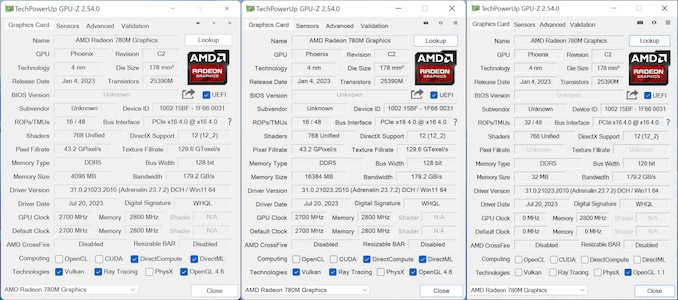
(From L to R: Default BIOS Settings, UMA Buffer Size set to 16G, UMA Buffer Size set to Auto)
Rembrandt-R's Radeon 680M had already achieved an industry-first by integrating hardware-accelerated ray tracing, and the Radeon 780M in Phoenix builds upon that. There are some improvements in the media engine too (such as AV1 encode support), but those are not revealed in the GPU-Z screenshot. The remaining subsections below look into the performance aspects.
GFXBench
The DirectX 12-based GFXBench tests from Kishonti are cross-platform, and available all the way down to smartphones. As such, they are not very taxing for discrete GPUs and modern integrated GPUs. We processed the offscreen versions of the 'Aztec Ruins' benchmark.
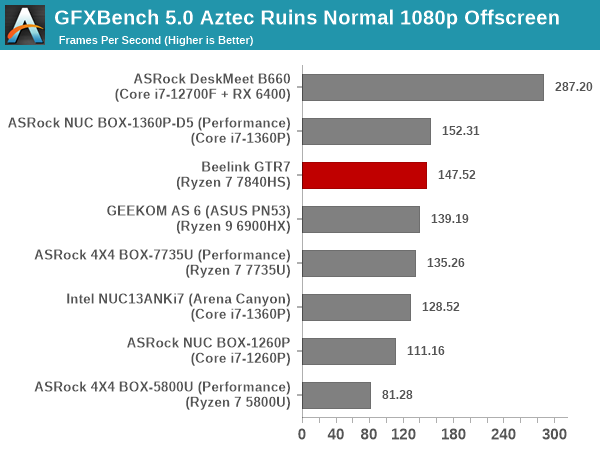
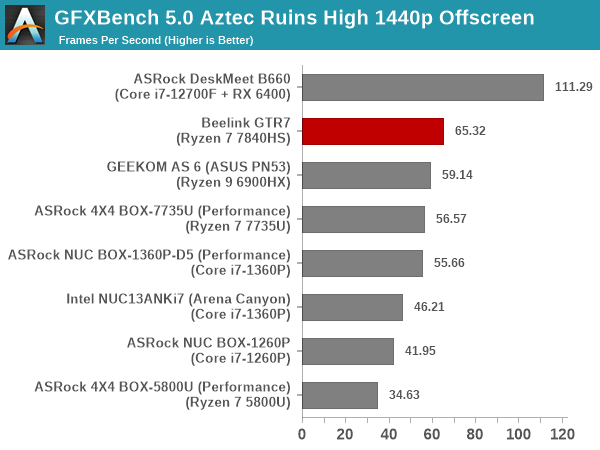
At 1080p, the souped-up ASRock Industrial Raptor Lake-P NUC has a slight edge of around 3% in the frame rate, but the AMD-based systems take back the crown at 1440p. The GTR7 has a 7% edge over the GEEKOM AS 6, which by itself has a 6% edge over the top RPL-P system.
UL 3DMark
Four different workload sets were processed in 3DMark - Fire Strike, Time Spy, Night Raid, and Wild Life.
3DMark Fire Strike
The Fire Strike benchmark has three workloads. The base version is meant for high-performance gaming PCs. It uses DirectX 11 (feature level 11) to render frames at 1920 x 1080. The Extreme version targets 1440p gaming requirements, while the Ultra version targets 4K gaming system, and renders at 3840 x 2160. The graph below presents the overall score for the Fire Strike Extreme and Fire Strike Ultra benchmark across all the systems that are being compared.
| UL 3DMark - Fire Strike Workloads | |||
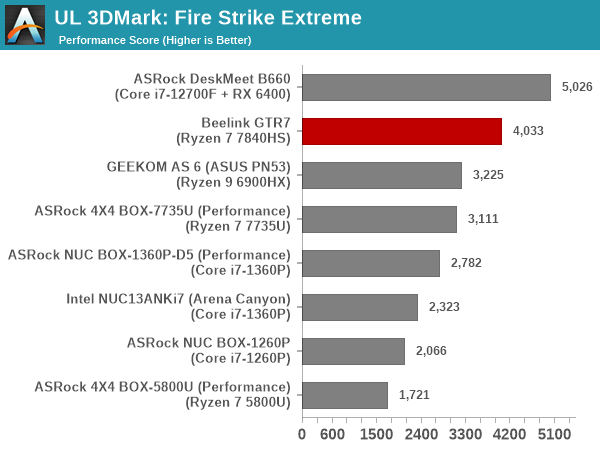
Rembrandt-R already had an edge over RPL-P in these workloads, and Phoenix only cements this position further. The GTR7 shows a 25 - 30% improvement over the GEEKOM AS 6 behind it - a result of the microarchitectural improvements as well as higher power budget.
3DMark Time Spy
The Time Spy workload has two levels with different complexities. Both use DirectX 12 (feature level 11). However, the plain version targets high-performance gaming PCs with a 2560 x 1440 render resolution, while the Extreme version renders at 3840 x 2160 resolution. The graphs below present both numbers for all the systems that are being compared in this review.
| UL 3DMark - Time Spy Workloads | |||
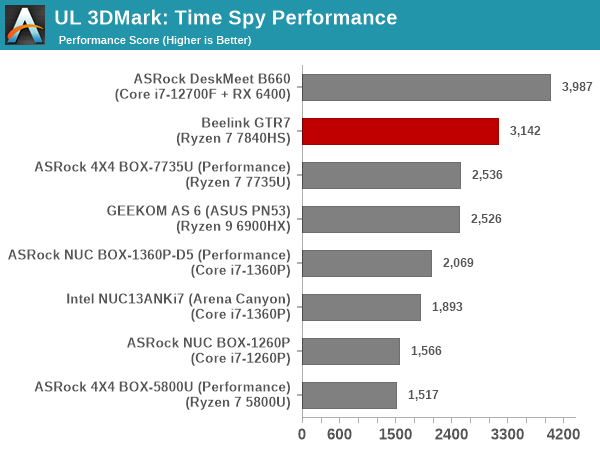
The observations made in Fire Strike workloads hold true for Time Spy also. The advantage for GTR7 over the 42W Ryzen 7 7735U in the ASRock Industrial 4X4 BOX-7735U is around 25%.
3DMark Wild Life
The Wild Life workload was initially introduced as a cross-platform GPU benchmark in 2020. It renders at a 2560 x 1440 resolution using Vulkan 1.1 APIs on Windows. It is a relatively short-running test, reflective of mobile GPU usage. In mid-2021, UL released the Wild Life Extreme workload that was a more demanding version that renders at 3840 x 2160 and runs for a much longer duration reflective of typical desktop gaming usage.
| UL 3DMark - Wild Life Workloads | |||
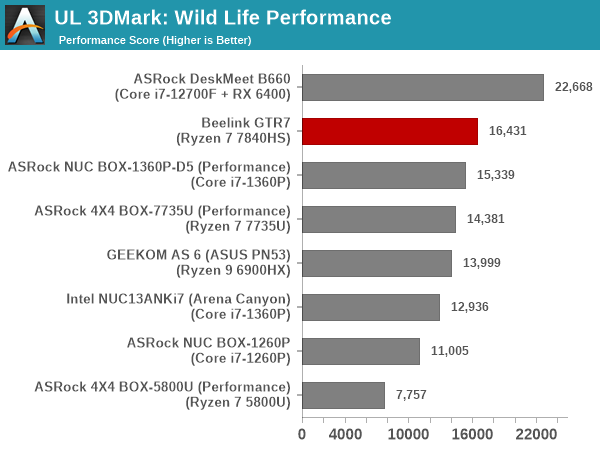
3D Mark Wild Life was one of the GPU workloads where RPL-P's iGPU had performed better than the Radeon 680M in the Rembrandt-R systems. The GTR7's Radeon 780M wrests the crown from the ASRock Industrial NUC BOX-1360P/D5, showing a 7% increase in performance at 1440p and 17% increase at 2160p. This is doubtless due to the improved microarchitecture and higher power budget.
3DMark Night Raid
The Night Raid workload is a DirectX 12 benchmark test. It is less demanding than Time Spy, and is optimized for integrated graphics. The graph below presents the overall score in this workload for different system configurations.
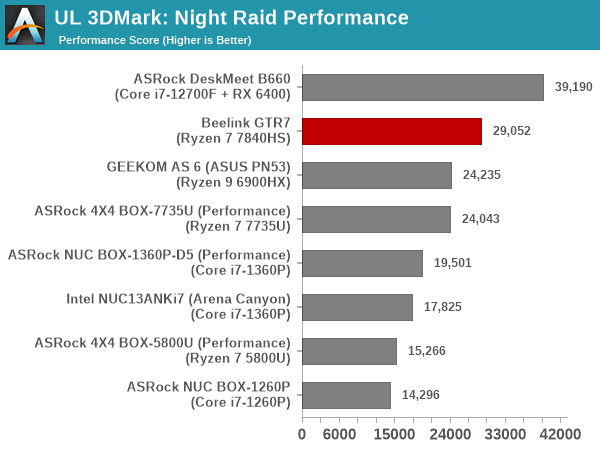
The GTR7 is comfortable on top when systems with iGPUs are considered, with a 20% advantage over the GEEKOM AS 6 (which has a 20% advantage over the best that RPL-P has to offer).
3DMark Port Royal
UL introduced the Port Royal ray-tracing benchmark as a DLC for 3DMark in early 2019. The scores serve as an indicator of how the system handles ray-tracing effects in real-time.
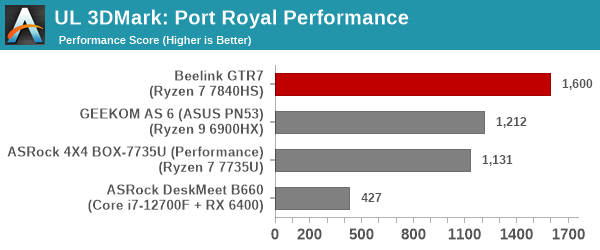
The GTR7 has a 30%+ advantage over the GEEKOM AS 6, thanks to improvements in the ray tracing engine, as well as faster iGPU clocks.


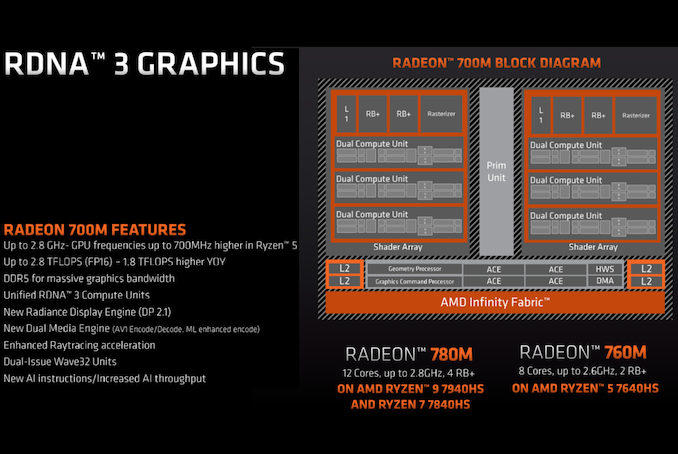








56 Comments
View All Comments
ganeshts - Friday, August 25, 2023 - link
The fan shown in the photo is for the RAM and the SSD (please take a look at the picture in the thermal characteristics section for more context on where that fan goes in the overall system).The fan behind the heat spreaders connected to the vapor chamber is not pictured in the article, but available in the cross-sectional view on Beelink's product page:
https://img.bee-link.com/media/upload/5/o2/5o29ppo...
It is a typical notebook fan, and combined with the vapor chamber, it is effective enough to handle the 65W cTDP setting.
abufrejoval - Friday, August 25, 2023 - link
"pro" vs. "non-pro" in APU or Ryzen G parlance used to indicate support for ECC RAM, which for some reason was *not* included for the APUs vs the "normal" Ryzens.So my question here is: does the Pro variant (with a Ryzen 7 7845) support ECC RAM?
Because that's pretty much the only remaining item on my wish lilst for this class of machine (well, I'd rather have them as Mini-ITX, but that doesn't seem to happen).
abufrejoval - Monday, August 28, 2023 - link
Just in case somebody else wonders: Pro vs. non-Pro evidently is no longer a differentitator for ECC support on the Phoenix series APUs. It's all in the "socket" or rather package; FP7 and FP8 do not support ECC while FP7r2 *can*, if the platform does, independent of the particular chips (Ryzen 3 vs 9) or the "Pro": each chip is available in each "socket" or form factor...And to muddy the waters even further, you can't tell the "socket" from the branding/model, I supposed there is a part number that will tell you but for a device like this, you'd mostly have to hope that the vendor will tell you.... fat chance, I'd say from past experience.
And looking at the *5 parts, I noticed that for Phoenix this is used to indicated the desktop die derived high-TDP mobile parts using the FL1 "socket": while the desktop chips generally support ECC, these mobile workstation parts absolutely do not, most likely because the FL1 "socket" otherwise would have required a couple of extra traces...
Sometimes I'd like to have a word with AMD's cost cutters, beause they keep cutting into vital flesh and kill entire market niches with their excess.
abufrejoval - Monday, August 28, 2023 - link
Digging further (sorry), the availability of DDR5 sockets seems to indicate FP7r2: FP7 and FP8 seem to be exclusively (soldered) LPDDR5.There are SO-DIMM 32GB, DDR5-4800, CL40-39-39, ECC, on-die ECC modules available from Kingston which are listed as dual-rank x8, while AMD lists "4x2R" support...
Ganesh if you happen to have some ECC DDR5 SO-DIMMs available I'd be really thankful for a test!
And the Dragon Range (desktop derived) FL1 "socket" parts definitely do not support LPDDR5,only (SO-)DIMMs but still no ECC....
jepo - Friday, August 25, 2023 - link
I bought one of these with the 7940HS via Aliexpress (679 gbp) in July after the review in ServeTheHome. It arrived in 2 weeks, same spec as this review except the 7940HS and mine is grey. I added an extra 2Tb Samsung 990 Pro SSD. To my surprise on first boot it has Windows 11 Pro installed. I gave it a CPU bound process to do that I expected to take 2 weeks given that is how long it would take on my 4 year old 3900X 12 core desktop. It completed in 10 days. During that time it was 100% CPU all cores. Yes the fan is quite noisy, but there was no throttling. In my opinion it's a great little box, and I've changed to use this as my main dev machne.shiromar - Monday, August 28, 2023 - link
I am consider something small and powerful for gen 7 game emulation. can this beelink handle the gen7 stuff?Also i would really like to install steamOS via holoiso. Does anyone know if this GPU plays nice with holo?
thanks